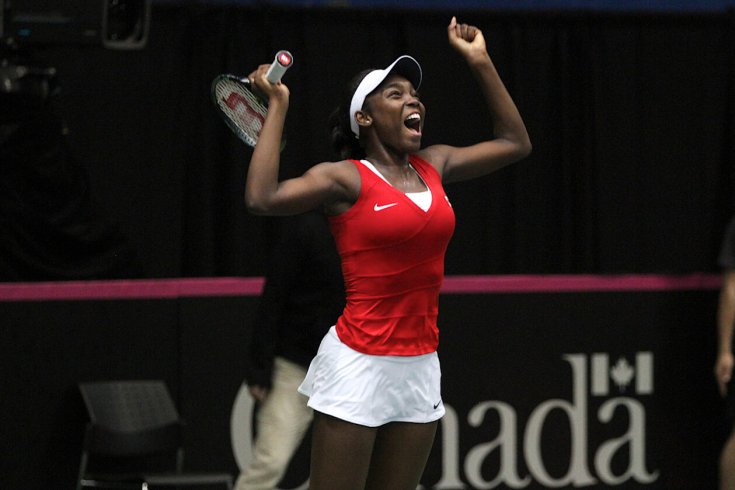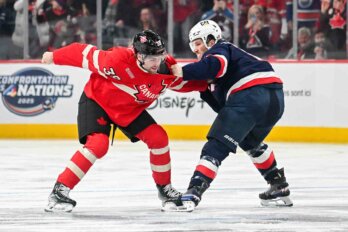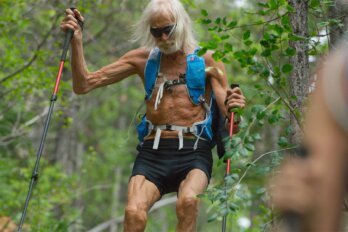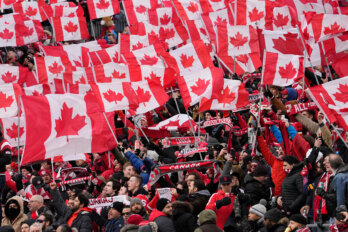In its 128 year history, the Rogers Cup has gone by a few different names, the Canadian National Championships, the du Maurier Open, and back in July 1995, when David Foster Wallace was profiling and semi-stalking the American player Michael Joyce, it was called the Canadian Open. After his first match, Joyce explained to Wallace that his opponent, a Canadian college star named Dan Brakus, “had a big serve, but the guy didn’t belong on a pro court.”
And that was pretty much the state of Canadian tennis. Neither Brakus, nor any of the other five Canadians playing that year, made it past the second round. We had players of fitful talent but how many really belonged on a pro court? Back then, very few.
But twenty years on, should you walk into the grounds of the Rogers Cup and glance up at the main draws, you’ll see Canadian names likes Milos Raonic and Eugenie Bouchard and Vasek Pospisil, all of whom certainly belong on a pro court. All three have been Wimbledon finalists and Raonic has earned more than $15 million in prize-winnings and been ranked as high as number three in the world. You’ll also see the names of some younger talents like Françoise Abanda and Denis Shapovalov, who, along with the injured Félix Auger-Aliassime, are poised to be as big, and some say bigger, than any Canadian cohort ever—a sea-change in sensibility and achievement the likes of which this country has never seen before.
In 2004, Tennis Canada hired Michael Downey as CEO. At the time, the highest ranked Canadians were Maureen Drake (No. 147) and Frédéric Niemeyer (No. 148) but Tennis Canada, as its website indicates, had a “vision to become a world-leading tennis nation.” Downey was a surprising choice. He had zero tennis experience, didn’t know Federer from Fedorov, but, after positions with Labatt’s, Raptors, Maple Leafs, and Molson’s, he knew marketing. “It’s really a business job and how to grow our revenues,” he said at the time.
Downey chose to focus on “best practices” tennis development. That is, looking at the foremost programs in the world—France, the US—and duplicating them in Canada. A first step was to bring Louis Borfiga, then with France’s Tennis Federation, to Montréal where Tennis Canada was constructing a new National Training Centre. “I was the chair of Tennis Canada when we approached Louis,” remembers Jack Graham, now a director emeritus. “Basically we decided we were going to play to win. Put our resources into high-performance. And drive the interest and the buzz in the sport in that way.”
Play to win. It’s a phrase key to Borfiga. “Everybody here was playing to play,” he told SportsNet. “Not playing to win. We had to change that mentality.” True. Outside of hockey—which rebounds between national fixation, religious obsession, and ongoing identity crisis—Canada historically has had more of a happy-to-be-invited attitude, rather than a let’s-win-this-thing killer instinct, particularly in pursuits such as tennis. The “Own the Podium” program at the recent Vancouver Olympics was an attempt to redress that attitude but for some the campaign seemed unsportsmanlike, presumptuous, too brash, abrupt—and artificial—a change.
The thing is, saying you’re going to change a mentality and organically implementing that change are two different things entirely. And, to do the latter, Borfiga needed money. Lots of it.
Tennis Canada owns the Rogers Cup and its operations are funded from its profits. Downey and Graham, sensing business was growing—and indeed in 2007 and 2008 the tournament would set records in sales, attendance, and profitability—realized that much more capital was needed. They chose to adjust Tennis Canada’s long-term debt on the new stadiums to allow for an increase in the investment in younger talent. How much increase? “Triple the money,” says Graham, describing an increase per year from $3.5 million to roughly $12 million. “So we could significantly advance our own player development.” And so was born the National Training Centre.
Before the NTC opened in 2007, the options for a gifted junior player in Canada were few. Go it alone, which was how Daniel Nestor did it, or go to some expensive private tennis academy in Florida, which was how Carling Bassett did it.
With the opening of the NTC, a junior player, while billeted with a Montréal family, can take daily advantage of the coaching, tutoring, physio, and state-of-the-art gym, and, of course, the tennis courts—twelve indoor, twelve outdoor, four clay—but they can also acquire something more. Before all this, tennis development in Canada had been pretty Balkanized. Borfiga realized the value in centralizing the best young players and communicating to them—as a group—the techniques, tactics, and belief they’d require in order to win no matter what the court, no matter who the opponent.
“Canada is so dispersed, so big,” said Raonic this week at a press conference marking the NTC’s tenth anniversary. “It was very important to bring people together. Being here was quite formative for me throughout the transition years from juniors into pros.”
Raonic moved to Montréal when he was 16. Montréaler Françoise Abanda was invited to join the NTC when she was just 11 and it changed her young life. “Everything is being paid for by the federation,” she told media recently. “It takes the weight off your shoulders and you can play free and not worry that my parents are spending so much money.”
After a few ups and downs (being ranked No. 4 in the world as a 16 year-old in 2013; a recurrent shoulder injury) Abanda in the last year has learned the value of a mature mindset. “I’m learning that at the top level you have to be present, 100 percent, every point,” she told SportsNet journalist David Zarum. “In the juniors, you could kind of do whatever and still win … In the pros, it’s like every point, every detail is perfect. Everything has to be perfect.”
Abanda was pretty perfect at Wimbledon this last July, winning her qualifying matches, straight-setting her first round, but losing a nail-biter to French Open champion Jelana Ostapenko in the second. Had she gone deeper, she would’ve faced her childhood idol Venus Williams. Currently 132 in the world, the highest-ranked Canadian after Bouchard, and only 20, Abanda may still have a few things to learn but, as Venus Williams herself has pointed out, Abanda plays with a lot of poise even if she doesn’t have all the experience. Experience, of course, will arrive.
It certainly did for 18 year-old Denis Shapovalov, the youngest of the world’s top 150 tennis players. Although he chose not to go to the NTC, the national program has contributed to his development in other ways—including hiring his coach Marty Laurendeau and providing financing for both as they travelled to smaller tournaments—and of all the juniors rising, Shapovalov most personifies the play-to-win intensity so keenly championed by Borfiga. Sometimes to a fault.
Behind this spring in a Davis Cup match against Britain’s Kyle Edmund, an emotional Shapovalov smacked a ball into the air, hitting the chair-umpire in the eye and resulting in instant disqualification. To his credit, he apologized the next day. “Last night at my Davis Cup match I did something very unprofessional and inexcusable,” he posted on Twitter. “I take full responsibility for my action … I promise that I will learn from this and that this will not happen again. I hope you guys can forgive me.”
It’s safe to say, with his heroics this week at the Rogers Cup, fans have not only forgiven him—they are obsessed with him. After saving four match points in his opening match, Shapovalov has gone on to stun the tennis world by upsetting Grand Slam champions Juan Martin del Potro and Rafael Nadal. All three victories have had a crowd-on-its-feet, Game Seven playoff hockey intensity—fitting, as Wayne Gretzky, an avowed Shapovalov admirer, was courtside each time—and there’s been a feeling generally of a star being born. As Graham remarked afterward: “We’ve never had an 18 year-old perform at this level.” Totally true. No Canadian has ever played tennis with such backwards-baseball-cap, surfer dude swagger as Denis Shapovalov. Maybe that’s the point.
Shap Stick has got a lot of pop for his size,” remarked Brad Gilbert, the ESPN analyst, in a recent tweet. “Things are really looking up at the moment for two Canadian prospects, especially next-level talent FAA.”
FAA, or Félix Auger-Aliassime, recently won the Open de Sopra Steria, a Challenger event in Lyon, France (think of a Challenger event as the equivalent to minor league baseball with $125,000 in total prize money—by way of comparison, total prize money at the Rogers Cup is $4.9 million). Auger-Aliassime’s victory made him, at 16 years and 10 months old, the seventh youngest player in history to win a pro tournament. “It’s tough playing adults,” he said. “It’s very different from the juniors and Futures.”
Turning pro at 16 is something new for Canada and the precedent, as ever, seems to have been set by Milos Raonic, who, after his three years at the NTC, turned down a full scholarship to the University of Virginia. Pospisil and Bouchard made similar decisions. “I think that Milos, Vasek and Eugenie helped a lot of kids believe,” said Auger-Aliassime this week at the NTC’s tenth anniversary. “I think that the difference is that now there are many more young people who say to themselves ‘Why not?’”
And here, really, is what makes Tennis Canada’s new program so successful: belief. Before, nobody expected much from Canadian tennis players. Now, these young players are united by belief—a belief that they’re in it to win it, that they can make magic on the court. For those of us former junior players—who grew up driving across the province to play tournaments six hours away, who slept on gym floors and church basements, who sat out rain delays dreaming of crushing match points—it is an unparalleled turn of events.
“That’s what makes us good,” Auger-Aliassime has said. “We bring this kind of chemistry and energy when we play. It wouldn’t be the same if I was alone. Or if Denis was alone.”
After reading his essay on Michael Joyce, collected in A Supposedly Fun Thing I’ll Never Do Again, I wrote David Foster Wallace a fan letter, blathering about tennis generally and gently pointing out a few factual-grammatical errors.
“I actually lost to a kid from Halifax,” he wrote back. “In 1977 in a big tournament in Chicago. 2nd round. I don’t remember his name; he wasn’t that good; I played badly. (This happened a lot in tournaments; I had a Bad Head.) … Technical things: You’re right on the ‘Blue Velvet’ boner; the ‘is/are germane’ is intentional: that piece’s FNs are supposed to have a very informal conversational tone that comprises a lot of little errors. I actually teach a technical grammar class, so I can usually intimidate copyeditors with technical stuff like ‘indef. pronoun–verb asymmetry as part of an incomplete appositive whose semantic function is primarily recursive rather than discursive.’ That shit wouldn’t fly on a canny Nuck, probably.”
Twenty-two years later, in large part because of the initiatives put in place by Tennis Canada, we have an abundance of tennis-invested Canny Nucks, with pretty good heads, who not only belong on a pro court but who are set to own them. The belief is there. Go see it for yourself.




